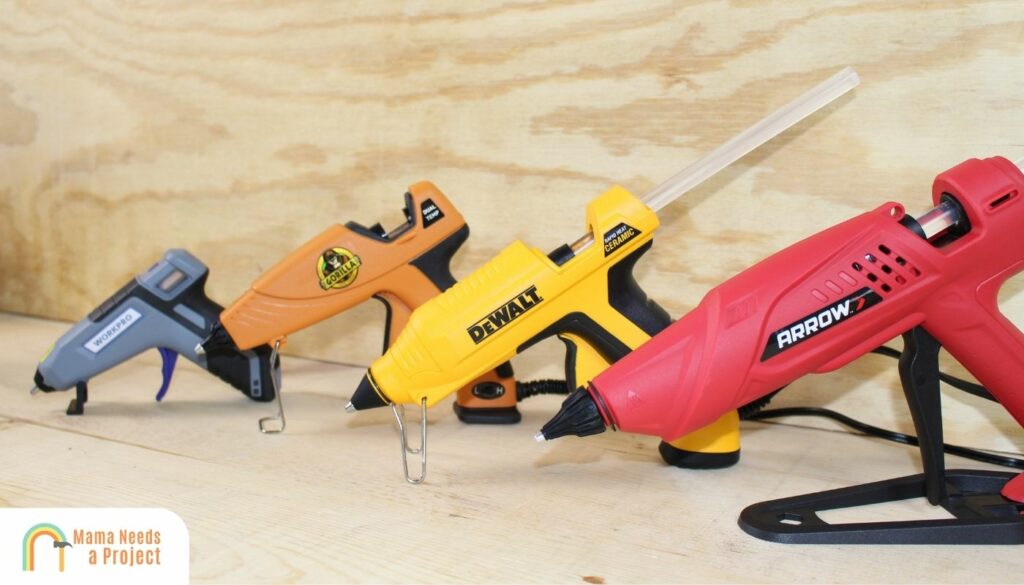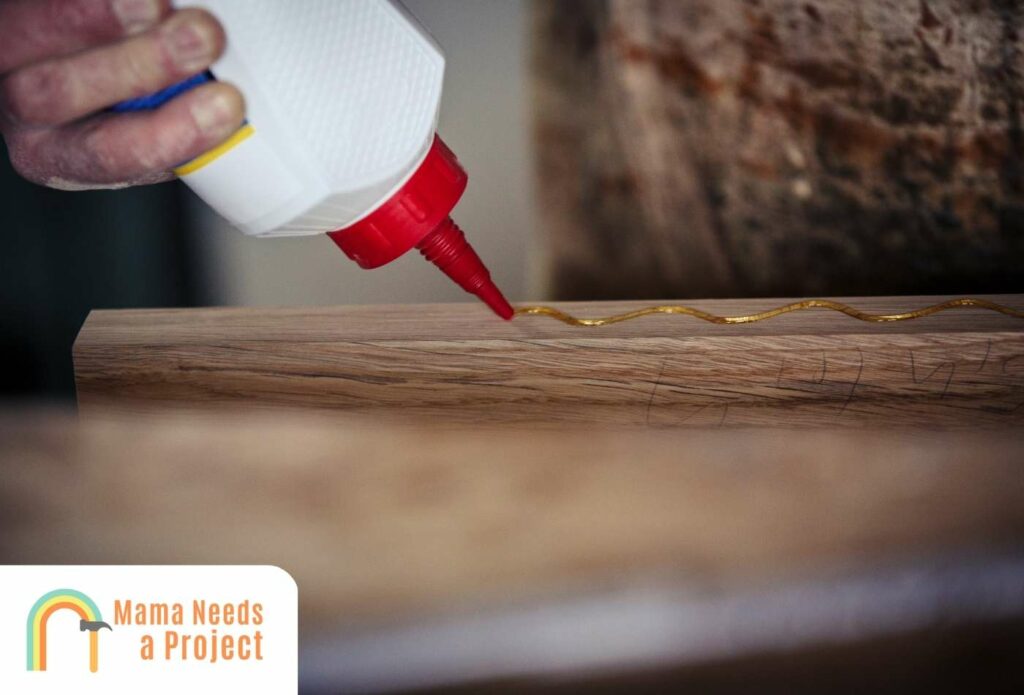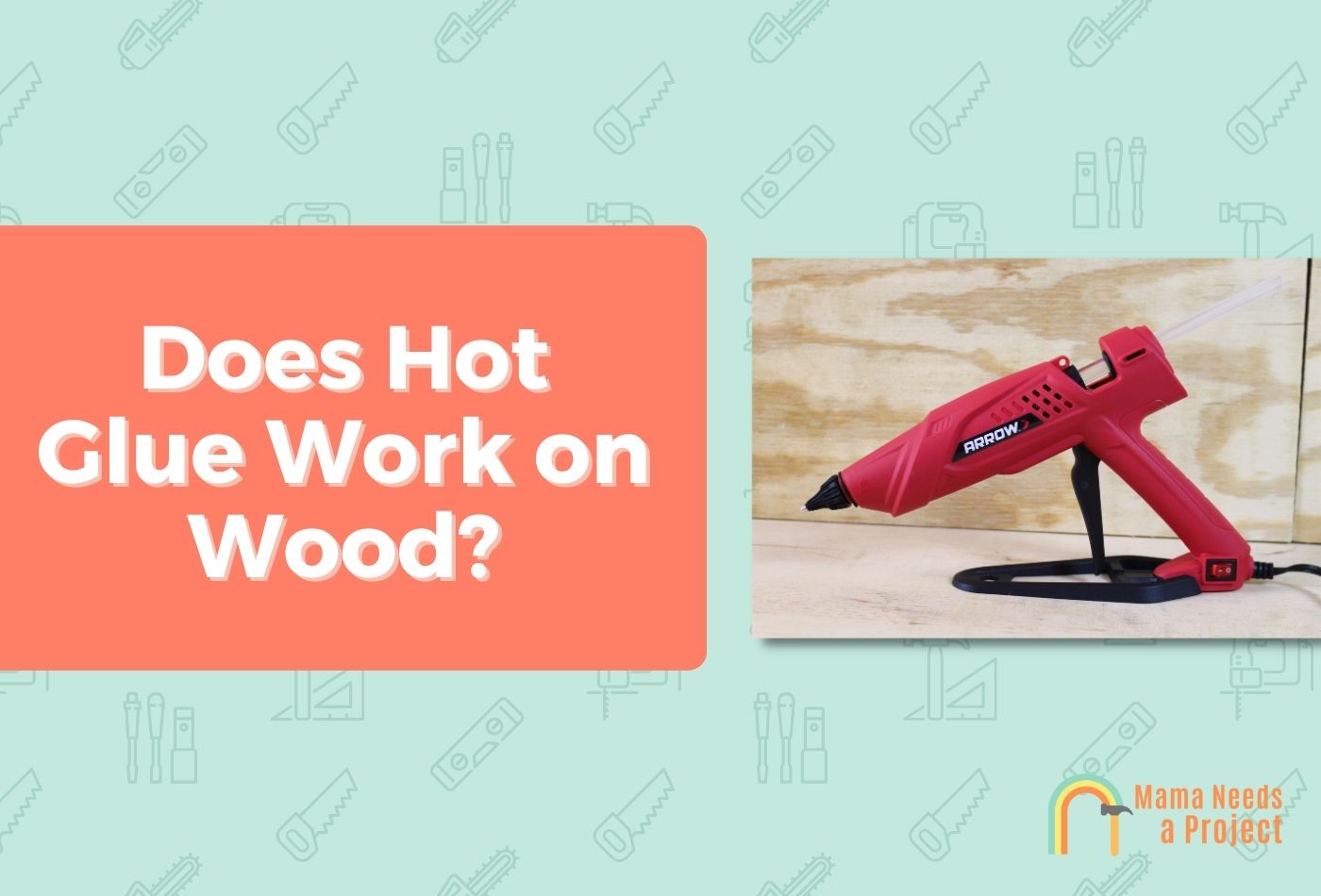Does Hot Glue Work on Wood? (Easy Tips & Tricks!)
- Yes, you can use hot glue on wood. While it’s not quite as strong as wood glue or epoxy – it can still bond wood together.
- To apply hot glue to wood, be sure the wood is clean and be sure to give it time to harden before moving it around.
Hot glue is one of the most versatile glues you can find, but does hot glue stick to wood?
In this guide, I’ll explore hot glue works with wood, how it compares to wood glue, and tips for applying hot glue. Let’s dig in!
Does Hot Glue Stick to Wood?
Yes! Hot glue does work on wood and you can use it on a wide range of projects. Don’t expect a bond as strong as a wood glue, but it can be a great product to get a temporary bond.

Using Hot Glue for Woodworking
1. Temporarily Joining Wood Pieces
If you want to join two pieces of wood temporarily, hot glue can be a simple way to accomplish this. Simply apply some dabs of hot glue along the sections that’ll be joined and allow it to dry.
2. Filling Cracks & Holes
Hot glue can also be used to fill cracks, holes, knots, gaps, and other imperfections that exist in wood. That said, this isn’t usually a go-to solution when woodworkers need to fill holes; instead they go for wood filler or wood putty.
If you need to fill a gap or hole in wood, and you don’t care about getting the best appearance afterward, hot glue is a cost-effective, easy-to-apply solution. But if you plan on staining or painting the wood after, use a stainable wood filler instead.
3. Combine With Wood Glue
Combining hot glue with wood glue creates a stronger adhesive, and you can use this mixture to secure two boards before clamping them.
While combining hot glue with wood glue is possible, it’s not really necessary, as either glue can provide an adequate bond on its own.
Read to learn if wood glue works on plastic and other surfaces!
4. Securing Baseboards
Hot glue is also used to hold baseboards in place while nails are being driven through them. Without the glue, there’s a chance the baseboards would move while the nails are being driven through, which can lead to a poor result.
5. Easier Sawing
Hot glue makes sawing through multiple pieces of wood at once a lot easier. With the glue securing the wood, you don’t have to worry as much about the wood moving as it’s being sawed.
6. Small Wood-Joining Tasks
If you need to join two small pieces of softwood together, hot glue can be used. In this case, the wood is so small, so using nails and screws isn’t possible. Hot glue provides a clean, transparent, and sturdy bond. And since it’s likely this wood won’t be subjected to a lot of weight, you won’t have to worry about it buckling.
7. Fixing Softer Materials to Wood
Need to attach paper, fabric, or another kind of soft material to a wood surface? Hot glue can be used if you want to avoid using tacks and other small placeholders that’ll poke holes through the material
8. Improved Routing
Hot glue can also be used to make routing easier. Specifically, you apply some hot glue to your workbench and then let it dry for a few moment. Next, fix the workpiece to the semi-dry hot glue.
Now begin routing. When you use the router, you won’t have to worry about fibers splitting, as while the workpiece is fixed to the glue, it isn’t so fixed that removing the bond after routing will result in damage.
Using this method, you cut out the need for a vice, which would prevent you from using the router on the entire workpiece.
Check out the video below for more info!
Does Hot Glue Make a Permanent or Temporary Bond?
Hot glue is mostly used as a temporary wood bond.
It can’t really support a large amount of weight or pressure since it doesn’t form a strong bond, so it’s not like you can glue a couple boards together, call them a shelf, and expect them to hold plants, books, and other heavy decorations.
In truth, hot glue is often used as a convenient substitute when wood glue isn’t available.
That said, some people prefer using extra-strength hot glue for a lot of their wood-joining tasks, as it makes driving nails and screws unnecessary.
If necessary, you can check out these ways to remove hot glue from wood.
Hot Glue vs. Hot Melt
Hot glue and hot melt aren’t two different adhesives, rather hot melt is a kind of hot glue.
Hot melt, as its name implies, heats at a higher temperature than low-melt (or standard) hot glue.
Just are there are different types of wood glues, there are different types of hot glue, like hot melt glue.
Because of its more liquefied nature, hot melt can provide a stronger bond when it dries. That said, using liquid glue can be more dangerous, as the glue is coming out at a much higher temperature.
Typically low-melt glue is used with those small, cheap glue guns that you can pick up at the local crafts store for $10-$20, whereas hot melt glue is mostly used by professionals when strong, fast-forming bonds are needed.
Despite being stronger than average hot glue, even hot melt glue isn’t strong enough to support a lot of weight and pressure. That said, it can still provide a sturdy bond between woods, light metals, ceramics, and plastics.
Because hot melt has a high melting point, you can use it in high-temperature areas and not worry about it melting; the same can’t be said for low-melt glues, obviously.
Both glues are somewhat water resistant which makes them perfect for exterior use.
Does Hot Glue Work on Painted Wood?
Yes, hot glue can be used to bond two painted surfaces.
Painting over hot glue, however, is a different story. In this case, you’re probably not going to get stellar results, as hot glue doesn’t absorb paint well.
One thing to keep in mind is that gluing and re-gluing painted surfaces can diminish the quality of the paint, and eventually you may have to scrape the paint off with a tool. In this case, you’d probably be forced to damage the paint and the wood to remove the dried glue.
Therefore, it’s best to do temporary gluing before you paint wooden surfaces.
Does Hot Glue Work on Damaged Wood?
Hot glue can be used on damaged wood, but the wood has to be porous. For this reason, if wood has poor structural integrity, it’s likely using hot glue to fill cracks won’t be that effective.
Hot glue needs to adhere to wood, and it can do this well if it’s applied to a smooth or lightly sanded surface.
Is Wood Glue Stronger Than Hot Glue?

The reason why most people opt for wood glue over hot glue—when it comes to bonding wood—is because wood glue is stronger.
That said, wood glue is only good for bonding wood to wood, whereas hot glue can be used to glue other materials to wood, like paper, fabric, plastic, and ceramic.
Also, hot glue dries quicker, but both glues are easy to apply. And both glues can effectively fill holes, gaps, and other imperfections that exist in wood.
The reason why wood glue is stronger than hot glue is because wood glue adheres to wood fibers better. Because of this adhesion, good wood glue can bond wood joints for a long time, and you won’t have to worry about hot glue peel (like you would if you were using hot glue).
Plus, you can combine wood glue with sawdust to create an effective wood filler—something you can’t do with hot glue.
Finally, using wood glue isn’t dangerous, whereas operating a hot glue gun could lead to you burning yourself or inhaling toxic fumes (depending on what kind of hot glue sticks you use).
In short, hot glue is a suitable adhesive, but if you want a strong, long-lasting bond from a glue, opt for wood glue. This liquid glue is even better than hot melt adhesive, and applying it doesn’t require a glue gun.
How Do You Use a Hot Glue Gun on Wood?
It’s best to apply hot glue in small dabs; this way you don’t put on too much glue. Removing excess glue can be a messy hassle – which nobody wants.
Hot glue is applied with a hot glue gun. If you want a precise application, use a glue gun that liquefies the glue and dispenses it evenly.
Your glue gun’s nozzle should be the right size. For example, if you intend to dispense a lot of hot glue to cover a wide area, you should use a glue gun with a wider nozzle.
When applying hot glue, make sure you’re using gloves to reduce the risk of burning yourself. Wearing a mask may also be necessary if the glue you’re using emits fumes that can bring on a headache or nausea.
Hot glue bonds quickly when compared to a common wood glue, so you need to work fast so it doesn’t dry before your piece are joined.
How Long Does Hot Glue Take to Dry on Wood?
It takes wood glue just a couple minutes to dry after it’s been applied to a wooden surface. Hot glue starts to dry the second it’s dispensed from the glue gun, and it dries quickest on porous surfaces.
That isn’t to say it won’t dry quickly on smooth surfaces—it’s just that porous surfaces allow for faster drying, better adhesion, and easier application.
Does Gorilla Hot Glue Work on Wood?
You can use Gorilla Hot Glue with two pieces of wood to create a strong bond, but again this hot glue bond isn’t going to be as strong as the bond that comes from nailing or screwing wood joints together.
Depending on your woodworking project, you might want to opt for a traditional wood glue or hide glue to get the results you want.
While hot glue can be great for DIY projects, it’s not the strongest glue needed for a more long-lasting wood project.
Tips for Using Hot Glue When Woodworking
Use the Right Finish
When using hot glue to fill cracks and holes in wood, make sure you finish the wood with something that won’t dissolve the glue. If glue is dissolved after finish is applied, it could discolor the wood, prevent a complete finish from forming, or reveal the cracks and holes that were previously filled.
Bind Surfaces Immediately After Applying Glue
When you use hot glue to bind two wood surfaces, you need to join the surfaces together right after the glue is applied, as with each passing second the glue becomes drier. If you wait just a minute before joining the surfaces, it’s likely you won’t get good adhesion.
Use Hot Glue for Outdoor Projects
Both regular hot glue and hot melt glue can be used for exterior projects because they are water resistant. While they might not be able to handle extremely hot temperatures or high heat, if you live in an area with moderate climate, you can use hot glue on any outdoor project where regular glue won’t work.
Sand Before Applying Hot Glue
If you’re binding wood pieces together, sanding them and getting a smooth surface can help to achieve a stronger bond.
Use Hot Glue for Pictures
Using hot glue is a great way to seal pictures and mirrors in their frames. In these instances, you want to refrain from using anything that’d go through the material, which means a strong glue is perfect, provided it can support the weight.
Use Hot Glue for Hinges
If you’re attaching hinges to softwood and you don’t want to screw these in, hot glue can be a terrific substitute.
Final Thoughts
The answer to the question “can you use hot glue on wood,” is a resounding “yes!”
Woodworkers can use hot glue in a variety of ways, and it’s a great substitute when you don’t have or don’t want to use traditional wood glue.
And since there are a range of hot glue guns out there, you’re sure to find something that’ll allow you to apply hot glue effectively and efficiently.

